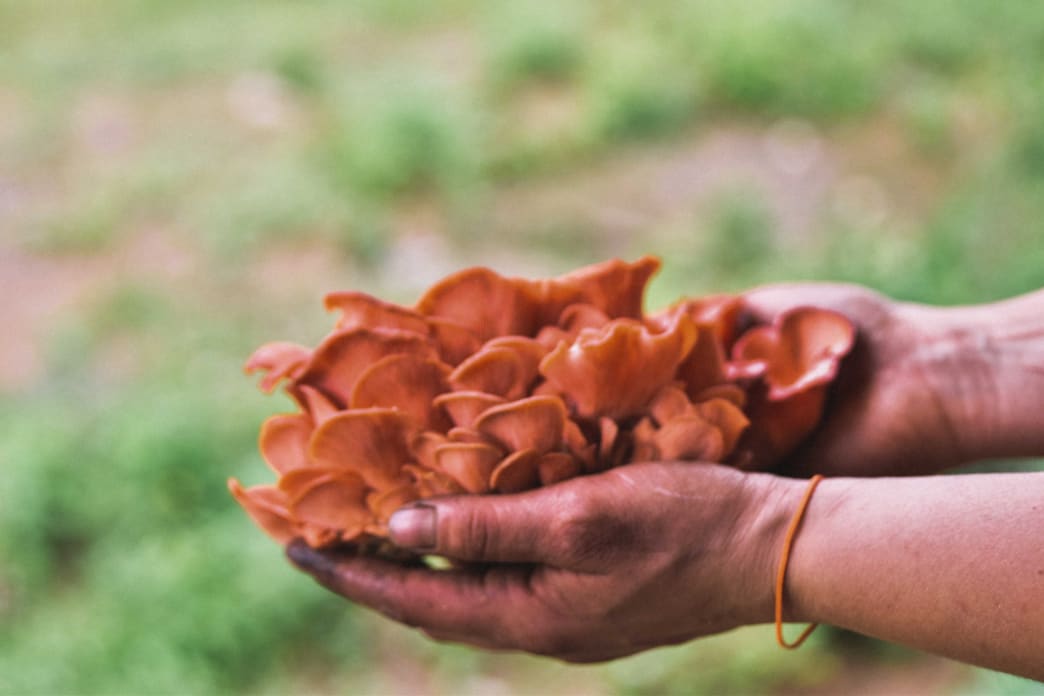Learn mushroom cultivation at home with our guidebooks and online course, and use our spawn products to help you get started with growing as soon as possible
Mushroom cultivation at home is easier than you may think, especially if you are willing to invest a little into the process.
Take a look below as we share some information on mushroom cultivation at home, including mushroom species we recommend you start with, in addition to resources that will help you get started quicker and easier.
Some popular mushroom species to try when learning mushroom cultivation at home
Here are three mushroom species we recommend you start growing at home. These mushrooms are easier to cultivate than many other gourmet edible mushrooms, and they taste great!
Shiitake mushroom: The shiitake is the second most-popular mushroom in the world behind the common button mushroom, and it is the most-consumed mushroom in Asia. The shiitake mushroom can add a lot of flavor and texture to a meal. When mildly cooked the shiitake is rich and buttery with a meatier texture than some other mushrooms, like the blue oyster. The flavor is smoky, nutty, and earthy when dried.
Shiitake mushrooms are most commonly grown on logs, but they can also be grown on supplemented hardwood sawdust. Depending on the strain, shiitakes can grow in a wide range of temperatures.
Blue oyster mushroom: The blue oyster mushrooms have a mild, yet complex taste. There’s a delicateness on the palate when you eat them. Their texture is velvety, and many chefs like to pair them with chicken dishes. The blue oysters from our mushroom growing kits grow fast and have a firmness to them that other oysters do not.
Oyster mushrooms can be grown on a variety of substrates, including logs, wood chips, supplemented sawdust, coffee grounds, straw, and even toilet paper.
Wine cap mushroom: These mushrooms are also known as garden giants, as they can get quite big. If you want to grow mushrooms in your garden bed at home, then this species is a great option. Wine cap has a burgundy cap, which is where the name comes from. It has a texture and taste like asparagus, and you can cook it in a variety of ways. Some people love to simply cut off the cap and grill it up just like a burger, bake them in the oven, or sauté with lemon juice, asparagus and chopped onions, garlic and almonds.
Wine cap mushrooms grow best in beds with softer hardwood wood chips or straw.
Our guidebooks for mushroom cultivation at home
We have six different guidebooks on mushroom growing that you can learn from!
I highly recommend checking those out, especially because we have one on growing oyster mushrooms and another on growing shiitake mushrooms. You will learn a lot about each mushroom, including some of the popular methods being used by professionals to grow these mushrooms. Even the guidebook page shares a lot of usable information for growing mushrooms in general.
Once you’ve started with the shiitake and oyster guidebooks, you can then move on to growing more complicated mushrooms, like cordyceps.
Online class on mushroom cultivation at home
We understand that reading guidebooks is not the desired way of learning for a lot of people. Some people want to hear a human voice, or see images and videos to better understand a certain subject. This is especially true for learning new information.
This is one of the many reasons we provide an online course for those interested in mushroom cultivation at home. This course includes audio and video in multiple webinars. In fact, the main aspect of this course is three 90-minute lectures. The course also shares videos and makes recommendations on additional resources to use. You can further your understanding and investigation of mushroom cultivation with readings we supply as well. You can then connect with our fungiphiles who have taken the course through a special private Facebook group for course alum.
Here is a rundown of the online course’s syllabus:
Week 1: Fungal Fundamentals
In this section you will learn about the ecology fungi and the mushroom life cycle. You will also learn the seven stages of mushroom cultivation during this lecture on the fundamentals. After the stages of cultivation you will learn more about spawn, including how to store it properly.
It is also in this section where we discuss the overall goals and intentions of the course, which is to get your growing mushrooms at home!
Week 2: Outdoor Cultivation
Next stop is the first lecture on cultivation, and we begin with the outdoor cultivation as that’s where the origins of mushroom farming lies.
In this lecture you will learn popular methods for growing shiitakes on logs, oyster mushrooms on straw, and wine cap on wood chip beds. So all of the mushrooms we recommended for beginning farmers are taught in this section of the course!
You will also learn about inoculating tree stumps, making wooden rafts, and totems. You can use a myriad of mushroom species for these methods of mushroom cultivation at home.
Week 3: Indoor Cultivation
The final part of the course focuses on indoor mushroom cultivation at home. Here you will learn about mushroom growing kits, which are a great introduction to mushroom farming. This section also discusses how you can grow oyster mushrooms indoors on spent coffee grounds.
This lecture also gets specific on how to expand mycelium and how to make your own spawn at home.

